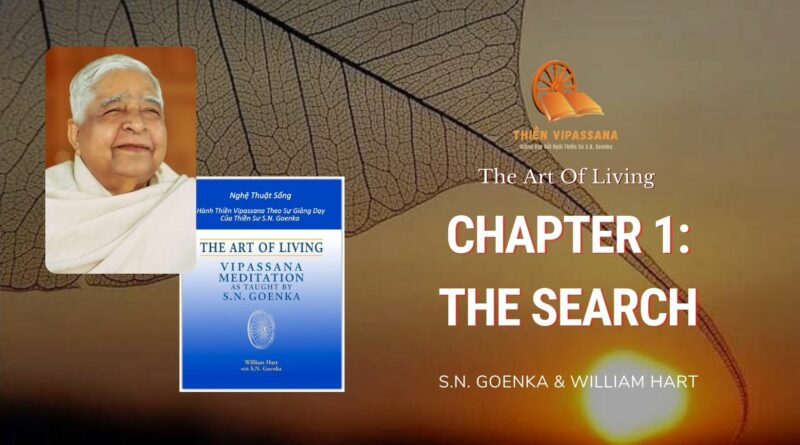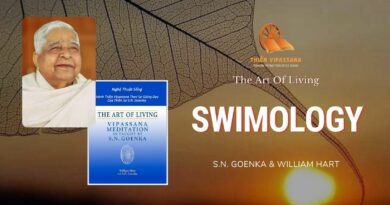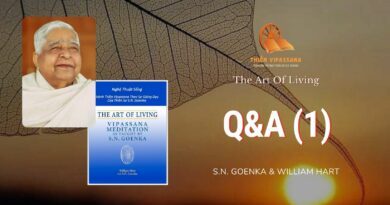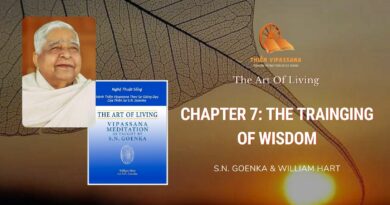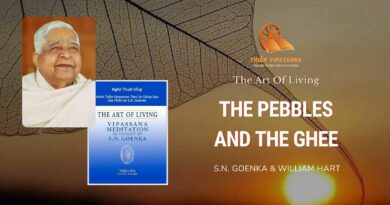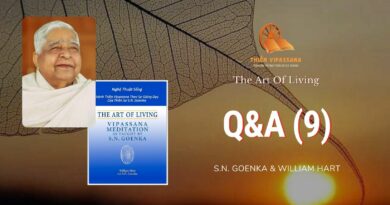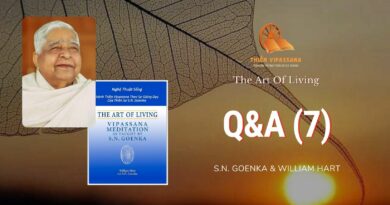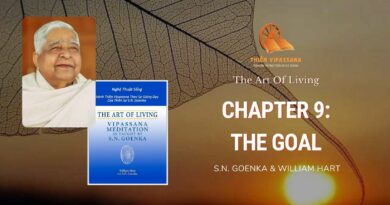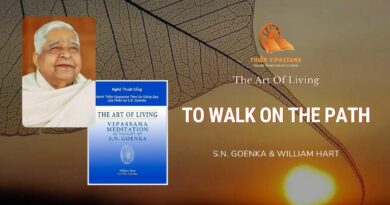Chapter 1. THE SEARCH
All of us seek peace and harmony, because this is what we lack in our lives. We all want to be happy; we regard it as our right. Yet happiness is a goal we strive toward more often than attain. At times we all experience dissatisfaction in life—agitation, irritation, disharmony, suffering. Even if at this moment we are free from such dissatisfactions, we can all remember a time when they afflicted us and can foresee a time when they may recur. Eventually we all must face the suffering of death.
Nor do our personal dissatisfactions remain limited to ourselves; instead, we keep sharing our suffering with others. The atmosphere around each unhappy person becomes charged with agitation, so that all who enter that environment may also feel agitated and unhappy. In this way individual tensions combine to create the tensions of society.
This is the basic problem of life: its unsatisfactory nature. Things happen that we do not want; things that we want do not happen. And we are ignorant of how or why this process works, just as we are each ignorant of our own beginning and end.
Twenty-five centuries ago in northern India, a man decided to investigate this problem, the problem of human suffering. After years of searching and trying various methods, he discovered a way to gain insight into the reality of his own nature and to experience true freedom from suffering. Having reached the highest goal of liberation, of release from misery and conflict, he devoted the rest of his life to helping others do as he had done, showing them the way to liberate themselves.
This person—Siddhattha Gotama, known as the Buddha, “the enlightened one”—never claimed to be anything other than a man. Like all great teachers he became the subject of legends, but no matter what marvelous stories were told of his past existences or his miraculous powers, still all accounts agree that he never claimed to be divine or to be divinely inspired. Whatever special qualities he had were pre-eminently human qualities that he had brought to perfection. Therefore, whatever he achieved is within the grasp of any human being who works as he did.
The Buddha did not teach any religion or philosophy or system of belief. He called his teaching Dhamma, that is, “law,” the law of nature. He had no interest in dogma or idle speculation. Instead he offered a universal, practical solution for a universal problem. “Now as before,” he said, “I teach about suffering and the eradication of suffering.”1 He refused even to discuss anything which did not lead to liberation from misery.
This teaching, he insisted, was not something that he had invented or that was divinely revealed to him.. It was simply the truth, reality, which by his own efforts he had succeeded in discovering, as many people before him had done, as many people after him would do. He claimed no monopoly on the truth.
Nor did he assert any special authority for his teaching—neither because of the faith that people had in him, nor because of the apparently logical nature of what he taught. On the contrary, he stated that it is proper to doubt and to test whatever is beyond one’s experience:
Do not simply believe whatever you are told, or whatever has been handed down from past generations, or what is common opinion, or whatever the scriptures say. Do not accept something as true merely by deduction or inference, or by considering outward appearances, or by partiality for a certain view, or because of its plausibility, or because your teacher tells you it is so. But when you yourselves directly know, “These principles are unwholesome, blameworthy, condemned by the wise; when adopted and carried out they lead to harm and suffering,” then you should abandon them. And when you yourselves directly know, “These principles are wholesome, blameless, praised by the wise; when adopted and carried out they lead to welfare and happiness,” then you should accept and practise them.2
The highest authority is one’s own experience of truth. Nothing should be accepted on faith alone; we have to examine to see whether it is logical, practical, beneficial. Nor having examined a teaching by means of our reason is it sufficient to accept it as true intellectually. If we are to benefit from the truth, we have to experience it directly. Only then can we know that it is really true. The Buddha always emphasized that he taught only what he had experienced by direct knowledge, and he encouraged others to develop such knowledge themselves, to become their own authorities: “Each of you, make yourself an island, make yourself your refuge; there is no other refuge. Make truth your island, make truth your refuge; there is no other refuge.”3
The only real refuge in life, the only solid ground on which to take a stand, the only authority that can give proper guidance and protection is truth, Dhamma, the law of nature, experienced and verified by oneself. Therefore in his teaching the Buddha always gave highest importance to the direct experience of truth. What he had experienced he explained as clearly as possible so that others might have guidelines with which to work toward their own realization of truth. He said, “The teaching I have presented does not have separate outward and inward versions. Nothing has been kept hidden in the fist of the teacher.”4 He had no esoteric doctrine for a chosen few. On the contrary, he wished to make the law of nature known as plainly and as widely as possible, so that as many people as possible might benefit from it.
Neither was he interested in establishing a sect or a personality cult with himself as its center. The personality of the one who teaches, he maintained, is of minor importance compared to the teaching. His purpose was to show others how to liberate themselves, not to turn them into blind devotees. To a follower who showed excessive veneration for him he said, “What do you gain by seeing this body, which is subject to corruption? He who sees the Dhamma sees me; he who sees me sees the Dhamma.”5
Devotion toward another person, no matter how saintly, is not sufficient to liberate anyone; there can be no liberation or salvation without direct experience of reality. Therefore truth has primacy, not the one who speaks it. All respect is due to whoever teaches the truth, but the best way to show that respect is by working to realize the truth oneself. When extravagant honors were paid to him near the end of his life, the Buddha commented, “This is not how an enlightened one is properly honored, or shown respect, or revered, or reverenced, or venerated. Rather it is the monk or nun, the lay male or female follower who steadfastly walks on the path of Dhamma from the first steps to the final goal, who practises Dhamma working in the right way, that honors, respects, reveres, reverences and venerates the enlightened one with the highest respect.”6
What the Buddha taught was a way that each human being can follow. He called this path the Noble Eightfold Path, meaning a practice of eight interrelated parts. It is noble in the sense that anyone who walks on the path is bound to become a noble-hearted, saintly person, freed from suffering.
It is a path of insight into the nature of reality, a path of truth-realization. In order to solve our problems, we have to see our situation as it really is. We must learn to recognize superficial, apparent reality, and also to penetrate beyond appearances so as to perceive subtler truths, then ultimate truth, and finally to experience the truth of freedom from suffering. Whatever name we choose to give this truth of liberation, whether nibbāna, “heaven,” or anything else, is unimportant. The important thing is to experience it.
The only way to experience truth directly is to look within, to observe oneself. All our lives we have been accustomed to look outward. We have always been interested in what is happening outside, what others are doing. We have rarely, if ever, tried to examine ourselves, our own mental and physical structure, our own actions, our own reality. Therefore we remain unknown to ourselves. We do not realize how harmful this ignorance is, how much we remain the slaves of forces within ourselves of which we are unaware.
This inner darkness must be dispelled to apprehend the truth. We must gain insight into our own nature in order to understand the nature of existence. Therefore the path that the Buddha showed is a path of introspection, of self-observation. He said, “Within this very fathom-long body containing the mind with its perceptions, I make known the universe, its origin, its cessation, and the way leading to its cessation.”7 The entire universe and the laws of nature by which it works are to be experienced within oneself. They can only be experienced within oneself.
The path is also a path of purification. We investigate the truth about ourselves not out of idle intellectual curiosity but rather with a definite purpose. By observing ourselves we become aware for the first time of the conditioned reactions, the prejudices that cloud our mental vision, that hide reality from us and produce suffering. We recognize the accumulated inner tensions that keep us agitated, miserable, and we realize they can be removed. Gradually we learn how to allow them to dissolve, and our minds become pure, peaceful, and happy.
The path is a process requiring continual application. Sudden breakthroughs may come, but they are the result of sustained efforts. It is necessary to work step by step; with every step, however, the benefits are immediate. We do not follow the path in the hope of accruing benefits to be enjoyed only in the future, of attaining after death a heaven that is known here only by conjecture. The benefits must be concrete, vivid, personal, experienced here and now.
Above all, it is a teaching to be practised. Simply having faith in the Buddha or his teachings will not help to free us from suffering; neither will a merely intellectual understanding of the path. Both of these are of value only if they inspire us to put the teachings into practice. Only the actual practice of what the Buddha taught will give concrete results and change our lives for the better. The Buddha said,
Someone may recite much of the texts, but if he does not practise them, such a heedless person is like a herdsman who only counts the cows of others; he does not enjoy the rewards of the life of a truth-seeker.
Another may be able to recite only a few words from the texts, but if he lives the life of Dhamma, taking steps on the path from its beginning to the goal, then he enjoys the rewards of the life of a truth-seeker.8
The path must be followed, the teaching must be implemented; otherwise it is a meaningless exercise.
It is not necessary to call oneself a Buddhist in order to practise this teaching. Labels are irrelevant. Suffering makes no distinctions, but is common to all; therefore the remedy, to be useful, must be equally applicable to all. Neither is the practice reserved only for recluses who are divorced from ordinary life. Certainly a period must be given in which to devote oneself exclusively to the task of learning how to practise, but having done so one must apply the teaching in daily life. Someone who forsakes home and worldly responsibilities in order to follow the path has the opportunity to work more intensively, to assimilate the teaching more deeply, and therefore to progress more quickly. On the other hand, someone involved in worldly life, juggling the claims of many different responsibilities, can give only limited time to the practice. But whether homeless or householder, one must apply Dhamma.
It is only applied Dhamma that gives results. If this is truly a way from suffering to peace, then as we progress in the practice we should become more happy in our daily lives, more harmonious, more at peace with ourselves. At the same time our relations with others should become more peaceful and harmonious. Instead of adding to the tensions of society, we should be able to make a positive contribution that will increase the happiness and welfare of all. To follow the path we must live the life of Dhamma, of truth, of purity. This is the proper way to implement the teaching. Dhamma, practised correctly, is the art of living.
Bài viết này được trích từ cuốn sách The Art Of Living – Thiền Sư S.N.Goenka và William Hart.

